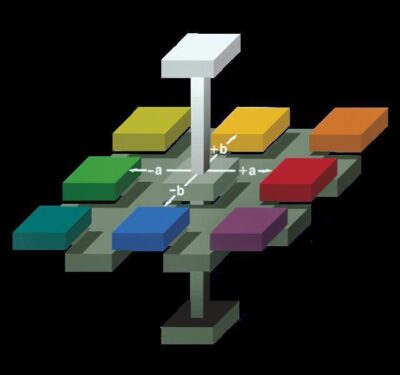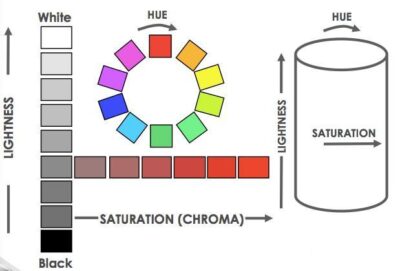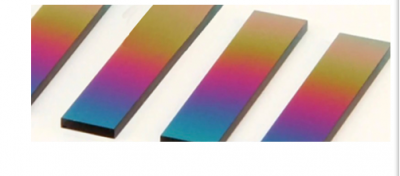1.1. Definition of “L, a, b“:

L a b 3D coordinate representation
During the 1950s-1960s, Hunter Lab established color spaces, represented in three-dimensional coordinates of L a b
“L” represents the brightness of the object: 0-100 means from black to white
“a” represents the reddish-green color of the object: positive values indicate red, negative values indicate green
“b” represents the yellow-blue color of the object: positive values indicate yellow, negative values indicate blue
1.2. Establish the meaning of the “L a b” color space
The “L a b” color space forms a unified color, color description language, and operating specifications. The “L a b” color space is one of the current universal spaces for measuring the color of objects, which is widely used in most fields. L a b can be used to represent the reflected or transmitted color of the physical sample. Unlike the RGB and CMYK color spaces, Lab Color is designed to approximate human vision, it is committed to perceptual uniformity, and its L component closely matches human perception of luminance.
Chromatic aberration is the concept of three-dimensional space using uniform color space, and the perceptual color difference between two colors can be calculated by formula, that is, the distance between two color points in the color space. Chromatic aberration is of great industrial significance. For example, in the printing and dyeing industry, in order to quantitatively evaluate the color quality of products, people hope to be able to measure color difference with a simple quantity, because the characteristics of color determine that it must be evaluated comprehensively with three attributes of color. The establishment of uniform color space makes the measurement of color and visual color difference closely related with instruments.
In 1976, CIE recommended two chromatic aberration formulas that were comparable in terms of the perception of chromatic aberration: the CIE LAB chromatic aberration formula and the CIE LUV chromatic aberration formula.
CIE LAB chromatic aberration formula:
CIE 1976 (L* a* b*) chromatic aberration formula, or CIE LAB chromatic aberration formula:
![]()
Where, the brightness difference:![]()
Chromaticity difference:![]()
![]()
where , are the brightness and chromaticity indices of samples 1 and 2, respectively, which can be determined by:

The calculation is obtained, where X, Y, Z are the triple stimulus values of the sample color; is the triple stimulation value obtained by the human eye after the surface of a completely diffuse object is passed through the CIE standard illuminator, wherein.
2.1 Definition of “L” “C ” “h”:

Three elements of color “L”, “C” and “h”
In the figure, “HUE” is the hue, represented by “h”, “CHROMA” is the chromaticity, and “C” is denoted by “C”. “L” stands for brightness, “C” is chromaticity, which is the degree of color saturation, and “h” is hue, which is the overall tendency of color. “L” , “C” and “h” are the three elements of color.
2.2. Establish the meaning of “L”, “C”, “h”
Brightness is the eye’s perception of the light source and the brightness of the surface of the object, and the brightness determines not only the degree of illumination of the object, but also the reflection coefficient of the surface of the object.
Saturation (chromination, freshness) usually refers to the vibrancy of a color. From a scientific point of view, the vibrancy of a color depends on the degree to which the hue emits a single light.
The characteristics of the hue are determined by the spectral composition of the light source and the perception of the human eye by the ratio of radiation of each wavelength reflected on the surface of the colored object. It is the qualitative appearance that color can present, and it is the standard for distinguishing various colors accurately. In many cases, we generally use (L a b) color space to describe color, but in some cases, such as brightness, saturation, but hue changes, we generally use L c h to describe color. For example, the classification of raisin color, measuring the change in the color of honey, and so on.
LISUN lauched Portable Spectrophotometer HSCD-800 is dual optical path design improves repeatability accuracy dE*ab≤0.04. The dual optical path design monitors the fluctuation of light source energy while measuring the sample signal, reduces interference during measurement, obtains higher measurement stability, and improves the measurement repeatability index of the instrument to dE*ab≤0.04. It guarantees the high standard of measurement speed, accuracy, stability and inter-station difference consistency of the instrument.
HSCD-860 Innovative 5-micron-thick nano-integrated optical device innovation is the soul. After nearly 10 years of painstaking research, the instrument uses nano-integrated optical devices as spectroscopic devices, and only 5 microns thick optical devices can achieve nano-level spectroscopic capabilities, once again leading the direction of industry innovation and surpassing the technology of foreign products. The blockade has greatly improved the technical performance of the product.

Optics with a thickness of 5 microns
Lisun Instruments Limited was found by LISUN GROUP in 2003. LISUN quality system has been strictly certified by ISO9001:2015. As a CIE Membership, LISUN products are designed based on CIE, IEC and other international or national standards. All products passed CE certificate and authenticated by the third party lab.
Our main products are Goniophotometer, Integrating Sphere, Spectroradiometer, Surge Generator, ESD Simulator Guns, EMI Receiver, EMC Test Equipment, Electrical Safety Tester, Environmental Chamber, Temperature Chamber, Climate Chamber, Thermal Chamber, Salt Spray Test, Dust Test Chamber, Waterproof Test, RoHS Test (EDXRF), Glow Wire Test and Needle Flame Test.
Please feel free to contact us if you need any support.
Tech Dep: Service@Lisungroup.com, Cell/WhatsApp:+8615317907381
Sales Dep: Sales@Lisungroup.com, Cell/WhatsApp:+8618117273997
Your email address will not be published. Required fields are marked *